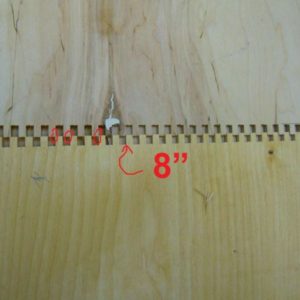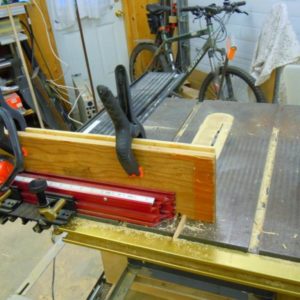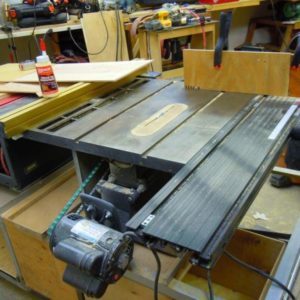Finger joints do not line up.
OK, I have subscribed to FWW of years, and have never had to ask a question. They say there is a first time for everything
I am feeling like a bit of a noob… lol
As you can see from the pics attached my box joints are going off after about 8″. These are 13 ½ “ tall.
I have looked at my set up and tried cutting new ones after readjusting the jig.
A few years back I bought the jessem sliding table, I was impressed with it at the wood show in Toronto, and regretted not buying it. Turned out to be a good thing… I was offered a deal I could not refuse when I was visiting a local shop. It is the accuracy I could never consistently get from any slot guided jig I built.
I have made lots of things but never box/finger joints over 6”. I am guessing that is why I have never run into this issue before.
The main fence for the joints is attached to the jessem fence and a sacrificial fence is screwed onto that.
Pin is cut from oak and fits snug. There is no side to side slop when cutting the joints.
There are drawers – to go on full extension slides. Any guidance is appreciated…


















Replies
You aren't off by much. One of the problems with box joints is that any small difference gets multiplied, the more pins, the more it will add up. Three things have to match identically, the blades, the space from those to key and the key. If the fit over the key is just a touch tight, so you have to use any pressure, it can push the pins.
Box joints are a difficult joint to cut that way. In the old days, a specialized machine was used, cutting all at once. Getting enough glue on them when assembling is a race and you need clamp pressure not only to pull the sides together but down wards to press the pins together. Ordinary wood glues can swell the pins making getting them together very hard. They are easily affected by cross grain wood movement. To keep them together over the long term, you really need to run a pin of some sort down through the joint. Probably not the best choice for drawers. When using metal slides, you don't really need fancy drawer joints.
Not off by much..
You know what, I bet that is what it is. I bet the key on the jig is too tight.. These are the tallest (or is it widest?) finger joints I have tried to make... Probably why I have never run into this before. I know I do not really need fancy joints, always thought finger joints were utilitarian. But these drawers are for my shop. And the 1/4 ply wood is perfect for these drawers. Plus I am tired of gluing and stapling I am expecting that once I get a sheet metal brake I will remake the drawers out of some sheet metal. But until I work out exactly what I want these are perfect, I have finger jointed shipping crates older than I am.. Just like the look. Thanks for the advice.
A Little Gorilla With a Metal Tooth
Some thoughts :
This is my jig that I made from plans in a book. Has a metal tooth that is adjustable across the jig. You just hold the last slot cut against the side of the tooth ( never a tight fit ). Easily dial able and then lock it down.
The sled with the sliding bottom, as well as back, seems like a good idea over all. Has a sacrificial strip that is on a sliding half dovetail. Cut it off; slide it over.
Be sure the runners in your table saw slots have no play. Should have adjustments for that but then you probably know all that.
As far as SWELL and time constrains just use Gorilla glue. Long open time and doesn't swell the work even though it can foam a bit. Use way less than other glues this prevents it from being a big mess that some new people have a problem with.
It is impossible to tell from the photographs, but I agree with Hammer - something in your setup is off by a hair, and the hairs add up until the fingers no longer mate. Often, the problem lies with the positioning of the guide pin and/or its width. To maintain alignment, the positioning of the guide pin needs to be dead on, and the stock needs to index off the same side of the pin for successive cuts.
Also, be sure your stock is perfectly square on the end cuts, and that the corresponding pieces are exactly the same length. A well tuned shooting board is helpful in this respect.
That said, I, too, prefer to cut box joints with a router on a good commercially-made jig of the appropriate size.
Ralph hit it on the head
>the stock needs to index off the same side of the pin for successive cuts.<
of coarse that goes along with the distortion created from the too tight pin pointed out by Hammer1. It is just that if the same side of the pin is faithfully used then it doesn't have to be a close fit. The metal tooth can be thin for small finger joints and still be rigid and still work for very large fingers.
PS: That brings another perameter to mind; if the snug pin is not perpendicular to the fence then it can introduce error by causing the tooth next to it to twist then it untwists when the tooth is moved over. A loose fitting tooth won't cause this even if the tooth is not square to the fence. The main thing is it doesn't change cut to cut and one side is always used.
Issue resolved...
I figure I cut 100 joints trying to fix the issue.
Then the light went on... Stop trying to make it perfect.
I just clamped all the boards together, flipped them and cut the other side.
Easy to set the offset for the sides, guaranteed alignment, every time.
Issue resolved...
I figure I cut 100 joints trying to fix the issue.
Then the light went on... Stop trying to make it perfect.
I just clamped all the boards together, flipped them and cut the other side.
Easy to set the offset for the sides, guaranteed alignment, every time.
Feel free to elaborate or post photos
I assume you are addressing everyone here in general but since the post was linked to my handle I figur'd I would post back.
I understand setting the off set
I think I am clear on clamping them all together.
What I am not clear on is :
Did you take some material off the key ? Was that an issue ? Sounds like it was for sure.
If not does that make the first board against the fence a sacrifice ? I can see how the others in the stack aren't spread by the key.
and the Stop trying to make it perfect comment wasn't it not fitting together ? Isn't like there were gaps as much as there was too much interference in the fit up.
Like I said not a big deal but I would like to know more about what you did if you have the time to post it.
Deleted
Dovetail Jig
Unfortunately my dovetail jig is MIA. Found a couple of templates in the shed, but that is it.
I am starting to wonder who I loaned it to… or better yet why. Of course like most things the harder I look for them the more out in the open it is hiding.
MIA tools
I solved that, kept finding missing tools at my sons house.
Just as you leave my shop, I placed a BIG clip board and a sign above it that says "ALL BORROWED TOOLS MUST BE SIGNED OUT"
This forum post is now archived. Commenting has been disabled